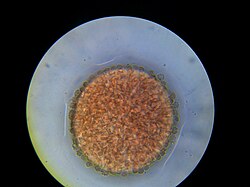Proerythroblast
This articleneeds additional citations forverification.(June 2020) |
| Proerythroblast | |
|---|---|
 Proerythroblast | |
 A comprehensive diagram of human hematopoiesis | |
| Details | |
| Gives rise to | Normoblast |
| Identifiers | |
| TH | H2.00.04.3.03002 |
| FMA | 83518 |
| Anatomical terms of microanatomy | |
Aproerythroblast(orrubriblast,orpronormoblast) is aprecursor cellto thenormoblast(nucleatedred blood cell), as the earliest of four stages in itsdevelopment.
Inhistology,it is very difficult to distinguish it from the other "-blast" cells (lymphoblast,myeloblast,monoblast,andmegakaryoblast). Thecytoplasmis blue in anH&E stain,indicating that it isbasophilic.
Proerythroblasts arise from theCFU-e(colony-forming uniterythroid) cells, and give rise to basophilicerythroblasts.In themouse,proerythroblasts are large committedprogenitorsthat express high levels oftransferrin receptor(iron acquisition receptor), theerythropoietin receptor(EpoR), somec-Kit (stem cell factor receptor),and are Ter119 (cell surface molecule)-positive. Their proliferative capacity is more limited compared to the preceding stage, the CFU-e.
In vivo,starting with the proerythroblast stage, erythroid cells undergo several morecell divisionswhile at the same time upregulating survival genes such asBcl-xL,acquiring and storing large amounts ofiron,ramping up the synthesis ofhemoglobinand other erythroid genes (in large part aGATA-1dependent process that is augmented by the EpoR signaling) and decreasing in cell size, eventually removing theirnucleiand being released into the bloodstream as areticulocyte.There are several Nucleoli on the nucleus and it occupies most of the cell volume. the chromatins are consist of a network of fine red pink strands. The distinguished feature of pro erythroblast to its corresponding myeloblast in granulocytic series is that it carries more basophilic peripheral cytoplasm.
"Pronormoblast" vs. "proerythroblast"
[edit]Some sources consider the terms "pronormoblast" and "proerythroblast" to besynonyms.[citation needed]However, other sources[1]consider "proerythroblast" to be a parent term, divided into the following two categories:
- "pronormoblast" - normal development
- "pr Omega loblast" - abnormal development
References
[edit]External links
[edit]- Histology image: 01804loa– Histology Learning System at Boston University - "Bone Marrow and Hemopoiesis: bone marrow smear, erythroblast series with proerythroblast"
- Histology image: 75_11at the University of Oklahoma Health Sciences Center
- Histology at KUMCblood-blood04
- Image and description at purdue.edu
- Histology of "pr Omega loblast" at marist.edu(pernicious anemia)
- Interactive image at usuarios.lycos.es
- Overview at temple.edu
